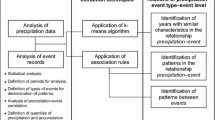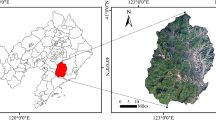Abstract
Disasters, both natural and man-made, are extreme and complex events with consequences that translate into a loss of life and/or destruction of properties. The advances in IT and Big Data analysis represent an opportunity for the development of resilient environments once the application of analytical methods allows extracting information from a significant amount of data, optimizing the decision-making processes. This research aims to apply the CRISP-DM methodology to extract information about incidents that occurred in the city of Lisbon with emphasis on occurrences that affected buildings, constituting a tool to assist in the management of the city. Through this research, it was verified that there are temporal and spatial patterns of occurrences that affected the city of Lisbon, with some types of occurrences having a higher incidence in certain periods of the year, such as floods and collapses that occur when there are high levels of precipitation. On the other hand, it was verified that the downtown area of the city is the area most affected by occurrences. Finally, machine learning models were applied to the data and the predictive model Random Forest obtained the best result with an accuracy of 58%.
Access this chapter
Tax calculation will be finalised at checkout
Purchases are for personal use only
Similar content being viewed by others
References
Wellington, J.J., Ramesh, P.: Role of Internet of Things in disaster management. In: 2017 International Conference on Innovations in Information, Embedded and Communication Systems (ICIIECS), pp. 1–4 (2017). https://doi.org/10.1109/ICIIECS.2017.8275928
Yang, C., Su, G., Chen, J.: Using big data to enhance crisis response and disaster resilience for a smart city. In: 2017 IEEE 2nd International Conference on Big Data Analysis (ICBDA), pp. 504–507 (2017). https://doi.org/10.1109/ICBDA.2017.8078684
Zagorecki, A., Johnson, D., Ristvej, J.: Data mining and machine learning in the context of disaster and crisis management. Int. J. Emerg. Manag. 9, 351–365 (2013). https://doi.org/10.1504/IJEM.2013.059879
(PDF) Crowdsourcing Disaster Response. https://www.researchgate.net/publication/268448750_Crowdsourcing_Disaster_Response. Accessed 26 Aug 2021
Shah, S.A., Seker, D.Z., Rathore, M.M., Hameed, S., Yahia, S.B., Draheim, D.: Towards disaster resilient smart cities: can internet of things and big data analytics be the game changers? IEEE Access 7, 91885–91903 (2019). https://doi.org/10.1109/ACCESS.2019.2928233
Chaudhari, S., Bhagat, A., Tarbani, N., Pund, M.: Dynamic notifications in smart cities for disaster management. In: Computational Intelligence in Data Mining, Singapore, pp. 177–1902019). https://doi.org/10.1007/978-981-10-8055-5_17
Shah, S.A., Seker, D.Z., Hameed, S., Draheim, D.: The rising role of big data analytics and IoT in disaster management: recent advances, taxonomy and prospects. IEEE Access 7, 54595–54614 (2019). https://doi.org/10.1109/ACCESS.2019.2913340
Na Minha Rua LX - Lisboa Inteligente. https://lisboainteligente.cm-lisboa.pt/lxi-iniciativas/na-minha-rua-lx/. Accessed 10 Aug 2021
Li, T., et al.: Data-driven techniques in disaster information management. ACM Comput. Surv. 50(1), 1–45 (2018). https://doi.org/10.1145/3017678
Moher, D., Liberati, A., Tetzlaff, J., Altman, D.G.: Preferred reporting items for systematic reviews and meta-analyses: The PRISMA statement. Int. J. Surg. 8(5), 336–341 (2010). https://doi.org/10.1016/j.ijsu.2010.02.007
Okoli, C., Schabram, K.: A guide to conducting a systematic literature review of information systems research. SSRN Electron. J. (2010). https://doi.org/10.2139/ssrn.1954824
Scopus - Document search. https://www.scopus.com/search/form.uri?display=basic&edit.scft=1#basic. Accessed 09 Aug 2021
About Google Scholar. https://scholar.google.com/intl/en/scholar/about.html. Accessed 09 Aug 2021
Jeong, M.-C., Kim, J.: Prediction and analysis of electrical accidents and risk due to climate change. Int. J. Environmental Res. Pub. Health 16(16), 2984 (2019). https://doi.org/10.3390/ijerph16162984
Abdullah, M.F., Ibrahim, M., Zulkifli, H.: Big data analytics framework for natural disaster management in Malaysia. In: Proceedings of the 2nd International Conference on Internet of Things, Big Data and Security, Porto, Portugal, pp. 406–411 (2017). https://doi.org/10.5220/0006367204060411
Briones-Estébanez, K.M., Ebecken, N.F.F.: Occurrence of emergencies and disaster analysis according to precipitation amount. Nat. Hazards 85(3), 1437–1459 (2016). https://doi.org/10.1007/s11069-016-2635-z
Alipour, A., Ahmadalipour, A., Abbaszadeh, P., Moradkhani, H.: Leveraging machine learning for predicting flash flood damage in the Southeast US. Environ. Res. Lett. 15(2), 024011 (2020). https://doi.org/10.1088/1748-9326/ab6edd
Park, J., et al.: Ensemble model development for the prediction of a disaster index in water treatment systems. Water Switz. 12(11), 1–19 (2020). https://doi.org/10.3390/w12113195
Saha, S., Shekhar, S., Sadhukhan, S., Das, P.: An analytics dashboard visualization for flood decision support system. J. Visual. 21(2), 295–307 (2017). https://doi.org/10.1007/s12650-017-0453-3
Célia, R., et al.: Mapping characteristics of at-risk population to disasters in the context of Brazilian early warning system. Int. J. Dis. Risk Reduct. 41, 101326 (2019). https://doi.org/10.1016/j.ijdrr.2019.101326
Lee, S., Lee, S., Lee, M.-J., Jung, H.-S.: Spatial assessment of urban flood susceptibility using data mining and geographic information system (GIS) tools. Sustainability 10(3), 648 (2018). https://doi.org/10.3390/su10030648
Liu, Y., Li, Z., Wei, B., Li, X., Fu, B.: Seismic vulnerability assessment at urban scale using data mining and GIScience technology: application to Urumqi (China). Geomat. Nat. Hazards Risk 10(1), 958–985 (2019). https://doi.org/10.1080/19475705.2018.1524400
Chen, W., Zhang, S., Li, R., Shahabi, H.: Performance evaluation of the GIS-based data mining techniques of best-first decision tree, random forest, and naïve Bayes tree for landslide susceptibility modeling. Sci. Total Environ. 644, 1006–1018 (2018). https://doi.org/10.1016/j.scitotenv.2018.06.389
Smith, S., et al.: Adoption of data-driven decision making in fire emergency management. In: Presented at the 24th European Conference on Information Systems, ECIS 2016 (2016)
Balahadia, F.F., Dadiz, B.G., Ramirez, R.R., Luvett, M., Lalata, J.P., Lagman, A.C.: Application of data mining approach for profiling fire incidents reports of bureau of fire and protection. In: 2019 International Conference on Computational Intelligence and Knowledge Economy (ICCIKE), pp. 713–717 (2019). https://doi.org/10.1109/ICCIKE47802.2019.9004420
Asgary, A., Ghaffari, A., Levy, J.: Spatial and temporal analyses of structural fire incidents and their causes: a case of Toronto, Canada. Fire Saf. J. 45(1), 44–57 (2010). https://doi.org/10.1016/j.firesaf.2009.10.002
Liu, X., Lu, Y., Xia, Z, Li, F., Zhang, T.: A data mining method for potential fire hazard analysis of urban buildings based on Bayesian network. In: Proceedings of the 2nd International Conference on Intelligent Information Processing, New York, NY, USA (2017). pp. 1–6. https://doi.org/10.1145/3144789.3144811
Lee, E.W., Yeoh, G., Cook, M., Lewis, C.: Data mining on fire records of New South Wales, Sydney. Procedia Eng. 71, 328–332 (2014). https://doi.org/10.1016/j.proeng.2014.04.047
Wang, Z., Xu, J., He, X., Wang, Y.: Analysis of spatiotemporal influence patterns of toxic gas monitoring concentrations in an urban drainage network based on IoT and GIS. Pattern Recognit. Lett. 138, 237–246 (2020). https://doi.org/10.1016/j.patrec.2020.07.022
[PDF] Crisp-dm: towards a standard process modell for data mining|Semantic scholar. https://www.semanticscholar.org/paper/Crisp-dm%3A-towards-a-standard-process-modell-for-Wirth-Hipp/48b9293cfd4297f855867ca278f7069abc6a9c24. Accessed 27 Aug 2021
Portal do INE. https://www.ine.pt/xportal/xmain?xpid=INE&xpgid=ine_inst_legislacao&xlang=pt. Accessed 04 May 2021
IPMA – Serviços. https://www.ipma.pt/pt/produtoseservicos/index.jsp?page=dados.xml. Accessed 04 May 2021
Author information
Authors and Affiliations
Corresponding author
Editor information
Editors and Affiliations
Rights and permissions
Copyright information
© 2022 ICST Institute for Computer Sciences, Social Informatics and Telecommunications Engineering
About this paper
Cite this paper
Gonçalves, S.P., Ferreira, J.C., Madureira, A. (2022). Data-Driven Disaster Management in a Smart City. In: Martins, A.L., Ferreira, J.C., Kocian, A. (eds) Intelligent Transport Systems. INTSYS 2021. Lecture Notes of the Institute for Computer Sciences, Social Informatics and Telecommunications Engineering, vol 426. Springer, Cham. https://doi.org/10.1007/978-3-030-97603-3_9
Download citation
DOI: https://doi.org/10.1007/978-3-030-97603-3_9
Published:
Publisher Name: Springer, Cham
Print ISBN: 978-3-030-97602-6
Online ISBN: 978-3-030-97603-3
eBook Packages: Computer ScienceComputer Science (R0)




